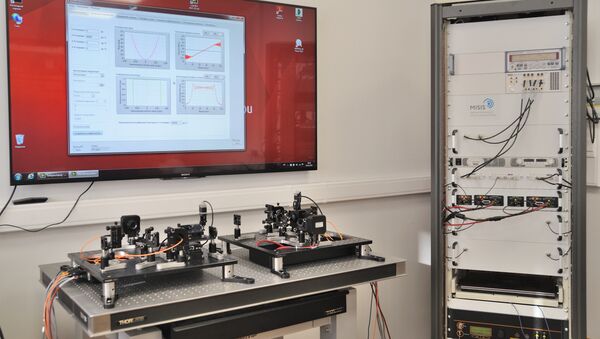The new equipment boasting record-breaking efficiency and resolution parameters will open up wide-ranging opportunities for controlling functional modes of powerful laser facilities in the Mega Science class.
Scientists from the Acousto-Optical Research Center at the National University of Science and Technology MISIS (NUST MISIS) and their colleagues from the Russian Federal Nuclear Center All-Russian Research Institute of Experimental Physics have developed a unique system for controlling powerful femtosecond laser systems, sources of ultra-high power light fields, for studying extreme states of matter and controlled thermonuclear fusion.
“The project to develop an equipment complex to generate laser pulses with unique efficiency parameters is quite topical. This is proved by the fact that NUST MISIS’ young scientists, namely, engineer Alexander Chizhikov and leading research associate Konstantin Yushkov, Ph. D. (Physics and Mathematics), have received the 2016 Russian Government Prize in Science and Technology,” Alevtina Chernikova, the Rector of NUST MISIS, said.
The adaptive control mode is essential for correcting laser pulse distortion during their subsequent propagation and amplification inside the laser system. The equipment complex uses a patented optical system, including two independent optical stages for the acousto-optical control of laser pulses. This allowed scientists to achieve maximum flexibility of the optical architecture and to expand the system’s functional potential.
“The new controlling system is an indispensable element of various femtosecond laser systems. It improves their key specifications, including output power, pulse duration and contrast range. These systems are becoming more and more popular in laser technology, innovative photonics technologies and in various areas of fundamental research. The new software/hardware system is particularly important for prototype and advanced powerful laser systems in the Mega Science class. By boosting the energy efficiency of these facilities through the adaptive correction of pulse-form distortion, it will be possible to cut their construction and maintenance expenses. The controlling system will allow scientists to expand adaptive control of the operating modes of unique powerful laser facilities,” Sergei Chizhikov, director of the Acousto-Optical Research Center at NUST MISIS, told RIA Novosti.
The new software/hardware system is designed to be used by a next-generation inertial confinement fusion facility, now being built in Russia. It will boost the emission intensity of the facility’s diagnostic channels, without consuming extra power. The equipment’s flexible architecture creates wide-ranging prospects for using it on other ultra-high power laser systems.
The idea of laser thermonuclear fusion is to heat and contract a target, a miniature thermonuclear fuel capsule/pellet, with the help of a powerful and short laser pulse. Laser pulses accomplish two major objectives: Powerful pulses directly “confine” the target, and a succession of shorter pulses makes it possible to assess the state of the target during contraction.
It took researchers about seven years to develop the system.



